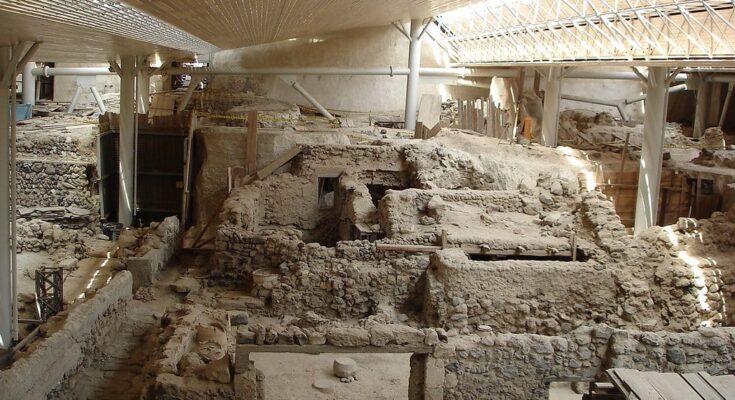
Throughout the twentieth century, archaeologists made many significant discoveries regarding the Minoan civilization. One major discovery was the fact that the island of Thera, or Santorini, had been the site of a massive Minoan settlement.
The eruption of this volcanic island initially appeared to coincide with the apparently mysterious disappearance of the Minoans. But were these two events really connected?
The eruption of Thera and the fall of the Minoans
The eruption of Thera was one of the largest eruptions in human history. Undoubtedly, volcanic eruptions can be very devastating, and they can even have a severely negative effect on the growth of crops for hundreds of miles around. In the case of volcanoes in the sea, they result in tsunamis which can strike nearby islands and coastlands.
When scientists first investigated the Theran eruption in significant depth, they placed it in the late 1500s or early 1400s BC. Interestingly, this is just a little bit earlier than the date for the fall of the Minoan civilization. Historians generally place this latter event in the mid-fifteenth century BC. It was at that time that the Mycenaeans conquered Minoan Crete.
Since Crete is not far from Thera, this raised the obvious possibility that the eruption of that island led to the fall of the Minoans. It was theorised that a tsunami must have struck the north coast of Crete. Later investigations have confirmed this. Many researchers argued that this must have weakened the Minoans, emboldening the Mycenaeans to attack and conquer them.
Chronological issues with this theory
The major issue with this seemingly convenient explanation for the downfall of the Minoans came as a result of a revised date given to the eruption of Thera. On the basis of ice core dating and radiocarbon dating evidence, scientists began placing this eruption in the 1600s BC rather than the 1500s.
This would mean that there was apparently a gap of almost two whole centuries between the eruption of Thera and the fall of the Minoan civilization. Even with the best will in the world, this would make it unviable to attribute the fall of the Minoans to the eruption of Thera.
Furthermore, the period between the eruption of Thera and the fall of the Minoans in the fifteenth century BC was marked by a major increase in building activity.
Egyptian chronology and other considerations
However, despite the apparent evidence from ice core dating and radiocarbon dating, not all the evidence agrees with such an early date. Other evidence supports the conclusion that the eruption of Thera happened much closer to the fall of the Minoans.
For example, there are many ash deposits in Egypt and other parts of the Levant which definitely came from Thera. These are dated to the reign of Ahmose I of Egypt, whose reign is usually placed predominantly in the latter half of the sixteenth century BC.
Furthermore, the most recent studies from radiocarbon evidence support such a conclusion. For example, there were four studies into this matter between 2021 and 2023. All four argued for a range which primarily falls in the sixteenth century BC. The most recent one placed it between 1610-1510, or 1602-1502 BC.
What this means for the eruption of Thera and the fall of the Minoans
What does this mean for the theory that the fall of the Minoan civilization was the result of the eruption of Thera? The obvious consequence is that it places the two events much closer to each other.
Another important factor is that the fall of the Minoans in c.1450 BC was not a sudden event. There is clear evidence that the Mycenaeans had been attacking the Minoans for decades before then. This is supported by the archaeological evidence that the Minoans were preparing for war at least as early as the early fifteenth century BC.
Early in the Late Bronze Age, generally dated to 1550 BC, the Minoan settlement on the island of Kythera was destroyed. It was undoubtedly the nearby Mycenaeans who did this. It is vital to appreciate that the date of the Late Bronze Age is fixed to the eruption of Thera. This is because the Late Bronze Age is fundamentally linked to the reign of Ahmose I, in whose reign we see the ash deposits from Thera.
At about the same time, there is evidence that the Minoans constructed defenses on some other islands of theirs. This supports the conclusion that they were facing attacks at that time.
This evidence of hostility from an external source continues right through to the final fall of the Minoans to the Mycenaeans around 1450 BC, suggesting that it was an ongoing conflict.
Therefore, it would appear that the Mycenaeans did indeed begin attacking the Minoans very soon after the eruption of Thera. This started a war which ultimately resulted in the fall of the Minoans.



